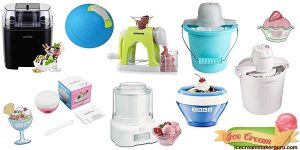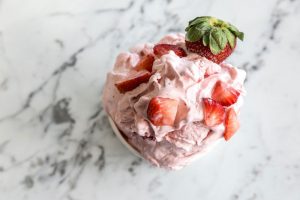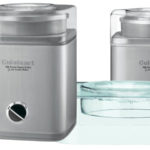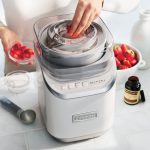The use of ice cream stabilizers has been a topic of heated debate among ice cream…
Ice Cream Emulsifiers — Your Questions Answered
Ice cream emulsifiers are considered a potent ingredient in ice cream making. While they have low use rates, they influence ice cream greatly. Ice cream emulsifiers impact the behavior, chemistry, and physics of ice cream by adopting a favorable position for it.
By managing the behavior of ice cream, its textural shelf life can be prolonged and ensures that it remains stable. Especially since ice cream is designed to be manufactured, stored, distributed, and eaten frozen.
If you’d like to find out more about this magical addition to making ice cream at home, read through our questions below!

What are emulsifiers?
Emulsifiers are two-faced molecules that can bind water and oil on different sides. One side is hydrophilic, and the other is hydrophobic.
Who created emulsifiers?
Although many natural emulsifiers are used in different ice cream recipes, Einar Viggo Schou, the founder of Palsgaard, invented the modern-day food emulsifier in 1917. Emulsifiers are safe to consume, and many even have health benefits!
Which emulsifiers are used in ice cream?
The most commonly used emulsifier in ice cream is mono- and diglycerides. When used, mono- and diglycerides contain approximately 40% monoglycerides. Typically, 0.1-0.2% mono- and diglycerides are used in regular ice cream, 0.5% with 60% monoglycerides in low-fat versions, and 0.6% with 60% monoglycerides in fat-free versions.
What do ice cream emulsifiers do?
If you like making ice cream at home, you know that all the help you can get is needed. Ice cream emulsifiers give your ice cream mix a boost in various ways:
Body and Creaminess: Emulsifiers act by binding fat and liquids together. This bond results in creaminess and fluff.
Foam Stability: Ice cream has a foam structure that forms during the freezing process. While a portion of the water is frozen, air is added to increase the product volume. Using emulsifiers ensures that this process is stable.
Heat Shock Stability: Temperature fluctuations experienced by ice cream products are referred to as the heat-shock effect. When this happens repeatedly, ice crystals melt and refreeze, resulting in a sandy ice cream texture. If you’re a home ice cream maker, using emulsifiers will help you stabilize the effect that temperature fluctuations have on your final product.
Unfortunately, there are also disadvantages to using emulsifiers:
Melting Rate: Emulsifiers reduce the amount of fat aggregates that form during the freezing process. This reduction has a direct influence on ice cream’s melting rate. The more fat aggregates there are, the more resistant ice cream will be to melt.

Are there any natural ice cream emulsifiers available?
When you’re unable to or wish not to use synthetic emulsifiers, there are two great natural options available: egg yolk and buttermilk.
Apart from water, egg yolk is primarily made from proteins and lipids. While not as efficient as synthetic counterparts, egg yolk still promotes the partial merging of fat. To induce a similar structure, you should use 1-2% of egg yolk.
When you’re churning cream, both buttermilk and sweet cream are produced. Sweet cream buttermilk and its powdered form can substitute milk in ice creams made without a synthetic emulsifier. Adding sweet cream buttermilk to your mixture will improve your end products’ appearance, color, texture, and whippability. It will also increase its shelf-life and reduce meltdown rates.
How do I fix a broken emulsion?
Emulsifiers are unstable by nature, and even if you’ve worked with them a thousand times before, they can still break or separate. When this happens, you can try to fix it by placing your broken emulsion in a blender to turn it into tiny droplets again.
What happens when I use too much emulsifier in my mix?
Making ice cream at home can quickly become a disaster when recipes aren’t followed to a tee. When you’re using ice cream emulsifiers, you need to be extra careful. Adding too much can cause a partial coalescence resulting in fat separation. Once fat separates from the emulsion, it clumps together and creates small, buttery lumps that are detectable on the tongue.
What happens when I use too little emulsifier?
If you didn’t add enough ice cream emulsifiers to your mix, partial merging wouldn’t occur while it’s being churned and frozen. You’ll be left with an unstable foamy consistency that’s coarse, wet, and melts quickly.
Why do some experts not like emulsifiers?
Although many ice cream makers see the use of emulsifiers as lazy, health experts also weigh in on their disadvantages. Some believe that emulsifiers disrupt gut health which can lead to disease and obesity. Others make it out as a cheap replacement for whole foods. However, when you’re an at-home ice cream maker, chances are you’ll be using natural emulsifiers, which are good food!

To Wrap It Up
After reading this article, we hope that the role of emulsifiers is clearer and more defined to you now. While stabilizers often overshadow them, ice cream emulsifiers play a big part in creating the perfect amount of air bubbles to make your at-home ice cream as creamy as it can be!
Although some people discourage using emulsifiers, the best way to know if they’re the right fit for you is by testing them yourself. Egg yolks will be enough for most homemade ice cream recipes, but other options might produce a cleaner, lighter texture and taste.
Experimenting with ice cream emulsifiers can be fun, so we encourage adding them to your ingredient list when making your next batch of delectable ice cream at home!
Join Me In The Fun of Making Ice Cream at Home!
Hi, my name is Simone and I LOVE making and eating ice cream. I have searched long and hard to find the best ice cream maker reviews and tips on the best ice cream makers.
Find out a little more about myself and the IceCream Maker Guru gang here.
Thanks for visiting and may your ice cream always be delicious!
Simone xx
Categories
Recent Posts
Most Popular Posts
Share with Friends
Related Posts
-
Ice Cream Stabilizers — Your Questions Answered
-
Cuisinart ICE-30BC Ice Cream Maker Review
Cuisinart ICE-30BC Ice Cream Maker Review - Based on all reviews and technical specifications Cuisinart…
-
Cuisinart Ice Cream Maker Comparison – Find the Best Cuisinart Ice Cream Maker for You
Money can never go wrong when you want to invest in a Cuisinart ice cream…







